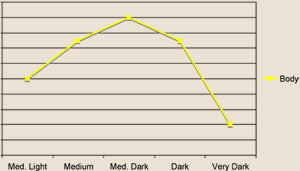
Second only to the quality of beans in the roaster, coffee roasting represents the single most important influence on flavor. The dynamic cause-effect process of roasting, whereby the degree of roast serves as the significant variable, is easy to understand but a considerable challenge to apply. Simply put, the longer coffee is held in the roaster and/or the higher the roasting temperature, the darker the bean. The darker the bean, the more bittersweet the flavor.
CHARACTERISTICS OF THE FIVE ROAST STYLES
Consider the chart below to understand how different roast styles, i.e., the degree of roast, affect the five key coffee traits: sweetness, body, aroma, acidity, and varietal character (the inherent taste qualities of a specific coffee):

TRACKING THE FIVE COFFEE TRAITS ACROSS ROAST STYLES
Relying on the general behavior of coffee beans in a roaster over the duration of a roast, the graphs below track each of the five coffee traits in isolation as heat is applied. The final graph merges the five traits into a pictorial representation of where each coffee trait exists in relation to the others across the five roast styles:






THE EFFECT OF ROAST STYLE ON COFFEE FLAVOR
As one reads the final graph vertically, consider the coffee traits as they line up above each roast style. What qualities do you most admire in a cup of coffee? If you prefer a bright, medium-bodied, aromatic cup that highlights varietal character, a coffee taken to a medium roast could be a perfect fit. Or perhaps a coffee with heightened body and sweetness paired with muted acidity is what you look for in a coffee, then a dark-roasted coffee should make your day.
At first glance, the graph might suggest that the best roast style for all coffees is medium dark since three of the five traits intersect near the graph's apex, with varietal character just below. Because of this, some roasters refer to a medium-dark roast as a "full flavor roast." At the same time, however, a medium-dark roast diminishes acidity, a favorable quality for many coffee drinkers, and mellows varietal character. At that level, the lemony notes characteristic of a lighter roasted Ethiopian, for example, would deepen to dark chocolate and dried fruit.
Roasting all coffees to the same level simply would not satisfy the taste preferences of customers whose coffee palates differ markedly. Further, the coffees that professional tasters most admire for their bright, fruity, and wine-like flavors are generally roasted with a lighter touch.
A soft, dry-processed Brazilian coffee, for example, requires a lighter roast to maximize flavor without harming its relatively fragile bean structure. Some high-grown washed coffees do well at a range of roast styles because their hard beans are able to withstand higher temperatures, yet they display equally favorable flavor profiles at varying degrees of roast. A fine Colombian is such a coffee. Still others exhibit celebrated qualities at a precise point in the roast. A Kenyan coffee, revered for its vibrant acidity and citrus notes, is one. If taken too far into a roast, the Kenyan's acidity suffers and its fruity notes deepen to pine.
THE COFFEE ROASTER'S FUNDAMENTAL GOAL
During the roasting process, the five primary coffee traits undergo continual transformation as, second by second, a coffee’s overall taste profile changes. A specialty coffee roaster's fundamental goal is to showcase each coffee's finest qualities. The roast style applied becomes a means to shape sweetness, body, aroma, acidity, and sweetness into a unified whole that complements rather than detracts from a coffee's overall flavor.
Note: This blog post, "The Effect of Roast Style on Coffee Flavor" was written and posted by Scribblers Coffee on August 25, 2010. We reposted this blog on our new website in 2017.